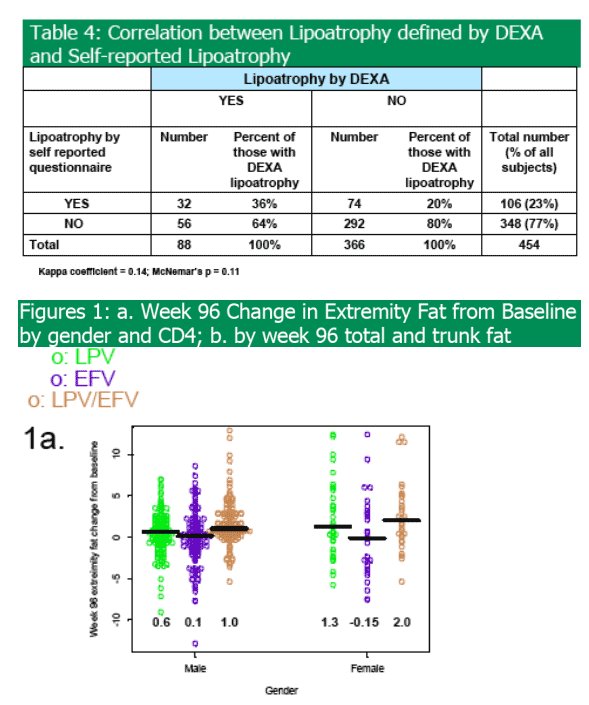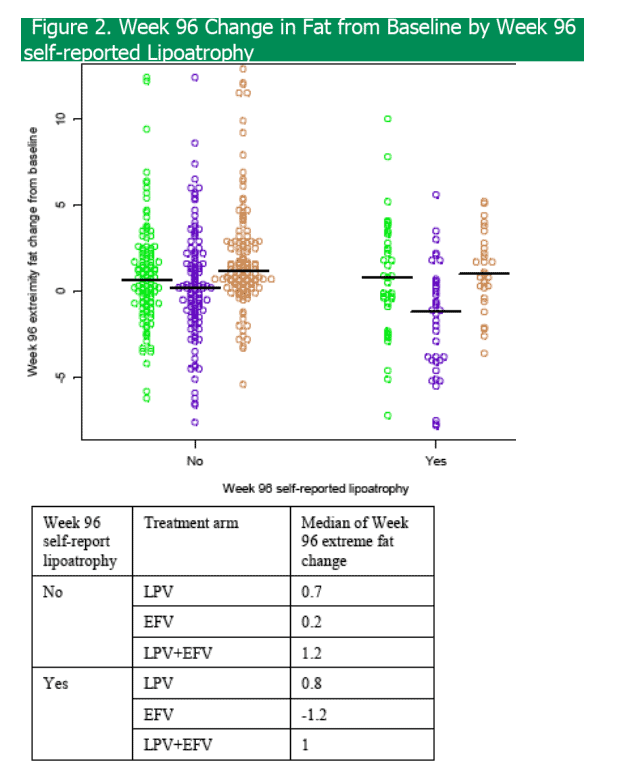 |
 |
 |
| |
Clinical Associations of Extremity Fat Loss from ACTG 5142: A Prospective, Randomized, Phase III Trial of NRTI-, PI-, and NNRTI-sparing Regimens for Antiretroviral Therapy (ART) of Naive, HIV-1 infected Subjects
|
| |
| |
Reported by Jules Levin
15th CROI, Feb 3-6, 2008, Boston
Richard H. Haubrich*1, Sharon A. Riddler2, Greg DiRienzo3, Yu Zheng3, William G. Powderly4, Kevin W. Garren5, David L. Butcher6, James F. Rooney7, John W. Mellors2, Diane V. Havlir8, and the ACTG 5142 Study Team
University of California, San Diego, San Diego, CA, USA1; University of Pittsburgh, Pittsburgh, PA, USA2; Harvard School of Public Health, Statistical and Data Analysis Center, Boston, United States3; University College, Dublin, Ireland4; Abbott Laboratories, Abbott Park, IL, USA5; Bristol-Myers Squibb, Plainsboro, NJ, USA6;Gilead Sciences, Foster City, CA, USA7 and University of California, San Francisco, San Francisco, CA, USA8
AUTHOR SUMMARY
· The NRTI-sparing arm had the least lipoatrophy (Table 1)
· Race/ ethnicity were not associated with lipoatrophy, other factors are shown in tables 2 & 3 and figure 1.
· Self-reported lipoatrophy by questionnaire did not correlate with DEXA findings (Kappa = 0.14, Table 4)
· subjects with self reported fat loss tended to gain less extremity fat at 96 weeks than subjects without self reported fat loss (median 0.25 vs 0.8 kg). (Figure 2)
AUTHOR CONCLUSIONS
Several factors were associated with DEXA-defined lipoatrophy (categorical) independently from ARV regimen
-- Higher baseline CD4
-- Less body weight gain
-- Less trunk fat gain
When analyzed as a continuous change in extremity fat, the following additional factors were independently associated with reduced extremity fat:
-- Male sex
-- Not having AIDS at baseline
-- Lower baseline extremity fat
-- Lower gains in cholesterol and LDL at week 12
-- Risk factors other than regimen may be important in the development of lipoatrophy and should be considered in prospective as well as cohort analyses of lipoatrophy
BACKGROUND
Extremity fat loss may be associated with factors other than antiretroviral
therapy (ART); these have not been well defined in prospective studies.
OBJECTIVES & ENDPOINTS
Objective: To evaluate risk factors, in addition to regimen selection, that are
associated with fat loss.
Endpoints:
· Lipoatrophy- defined as a 20% reduction in total extremity fat from
baseline, measured by DEXA
· Change in extremity fat from baseline to 96 weeks in kg
METHODS
· Phase III, randomized, multicenter, open-label, 96 week trial
· 753 subjects (20% women) were treated on study in three arms:
_ Efavirenz + 2 NRTI (EFV)
_ Lopinavir/r + 2 NRTI (LPV/r)
_ Lopinavir/r + Efavirenz (LPV/r-EFV)
· NRTI were chosen prior to randomization (3TC + ZDV, d4T XR or TDF)
· Randomization stratified: HIV RNA (≦100,000 or >100,000), hepatitis B or C, and NRTI choice
· Major inclusion criteria
_ Antiretroviral naive; Any CD4
_ HIV RNA ≥2000 copies/mL
· Fat Change Measures
_ DEXA (standardized protocol, read central by masked reviewers) at 0, 48 and 96 weeks
_ Self report at weeks 0, 24, 48, 72, 96
__ yes/ no question-"have you noticed any of the following during the past 4 weeks"; any yes scored as lipoatrophy
__ Your cheeks have sunken in (lost fat in the face)
__ You lost fat in your "butt"
__ You lost fat from your arms and/ or legs
· Statistics:
_ All analyses were ITT without adjustment for multiple comparisons or regimen changes
_ Multivariate models of the odds of lipoatrophy used logistic regression and change in extremity fat used linear regression. All models included randomized regimen and NRTI selection as covariates




|
| |
|
 |
 |
|
|